The Flower of Battle:
An Interview with Bob Charron
- Part 1
By Deborah Klens-Bigman
How The Interview Came About
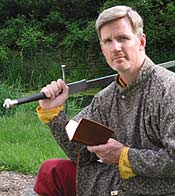 |
Bob Charron |
A few years ago I attended a Western Martial Arts workshop held in New
York City. Among all the workshops one of the most impressive was taught
by a graying, middle-aged man with a wise look – Bob Charrron.
He talked about a martial arts manual written in the 15th century that
he was translating from old Italian. The manual described a system, from
empty hand, to daggers, then to swords, then to lance tactics from horseback.
Not only that, the manual contained philosophical underpinnings. Animals
from a Medieval bestiary were set up to correspond to parts of the human
body - a lynx sat above a Medieval man's head with a calipers, implying
patience and logic, a lion on the right symbolized wisdom and courage,
a tiger on the left was for strength and ferocity (and was controlled
by the lion), and an elephant at the feet of the figure implied stability.
There were almost too many parallels with my own martial arts experience,
based in practices approximately as old, but from half a world away,
to consider all at once.
Bob Charron not only translating the work, but he was also recreating
and teaching the techniques illustrated and described in the manual.
The manual is the Fior di Battaglia ("The Flower of Battle" -
Flos Duellatorum in Latin), written by an Italian nobleman, Fiore dei
Liberi, probably before 1410. I was fascinated as Charron led workshop
students through a brief outline of de Liberi's manual - empty hand,
followed by dagger techniques, followed by sword techniques. I had to
learn more about this and thus decided to interview him for FightingArts.com.
I first did some research. This included reading a version of the Fior
di Battaglia on line (courtesy of a group called the Knights of the Wild
Rose - www.varmouries.com). This version is known as the Novati version
or the Pissani-Dosi version, and is described during the interview in
more detail. It is a bare outline with illustrations. It is not the same
as the more complete Getty Museum version that Charron is using for his
translation, but at least it was a start.
I began to look forward to the interview.
Charron lives in Madison, Wisconsin, where he teaches dei Liberi's techniques
through his St. Martins Academy of Arms. He also travels and teaches
de Liberi's techniques at seminars on behalf of the Association for Historical
Fencing and other organizations.
Incredibly (or not) it took me several years before I began the process
of interviewing Bob Charron. The interviews as done via questions sent
by email over a period of several weeks in late summer of 2003.
The Interview
Deborah Klens-Bigman: Tell me a little about your background - what
interested you in Western martial arts?
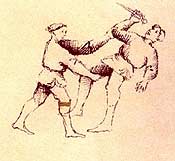 |
An attacker with a dagger is
foiled with a technique to unbalance him. Flos Duellatorum Pissani-Dosi
MS Carta 9 B.
|
Bob Charron: After receiving a degree in Education, I spent over 20
years in historical re-enactment. It was here that I developed my historical
curiosity until eventually I was finding such subjects as housing incentives
in the 12th century Levant fascinating (madness, maybe?). While one could
use statuary, household inventories and manuscript illuminations to determine
fashion, and could find extant prayer books, recipe books, books on grammar,
etc., there didn’t seem to be any primary sources for how weapons
were employed or how the knowledge of their use was transmitted. I tried
to derive all I could from primary sources, yet the closest references
I could find at that time were witnesses’ chronicles of Medieval
battles and deeds of arms. These were rare and not very informative.
I knew that individuals trained for years in structured programs of physical
culture and martial arts, but I had trouble pinning down the primary
sources for these programs. Through Greg Mele, a long-time friend and
fellow in frustration over the same topics, I discovered a small community
of individuals working diligently to locate and interpret primary source
treatises on this very subject. Once found, there was no doubt about
my dropping everything else to devote myself to this study.
DKB: What, specifically led you to Fiore dei Liberi?
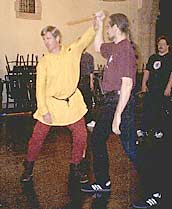 |
Bob Charron demonstrates one of his (a reconstructions of a 15th-century
technique) unarmed techniques of defense against a dagger attack
during a workshop on Western Martial Arts held in 2001. |
BC: I first found the Pissani-Dossi copy of the manuscript through the
web and read the Royal Armouries translation that was out several years
ago. I found the illustrations fascinating, but the rhyming couplets
of verse were frustrating in that they lacked important details necessary
for the execution of the techniques. Of course at that point I couldn’t
really translate them either, and was depending on a translation that
was later recalled due to quality.
I then acquired a copy of the Getty-Ludwig version of the treatise,
and found that there were entire paragraphs of text describing the techniques
in detail. It was then that I decided I had to learn the language and
translate the treatise in order to get to the heart of Fiore’s
teachings. I knew that if he was appointed to teach the art of arms at
the court of Nicolo d’Este he had to be very accomplished indeed.
Through working with all three copies of the manuscript (including the
Pierpoint-Morgan copy) and the biographical information of Fiore, I have
discovered that he was all that and more. His appointment to the court
at Ferrara, his very famous students, his five duels with other masters,
and his military career all testify to his reputation and experience.
I was also attracted to the idea of an entire system of martial arts
that covered hand-to-hand combat, knife fighting, swordplay, the use
of the spear and the pollaxe, and equestrian techniques through recurring
mechanics and concepts. There is a lifetime of work here. So the draw
was to the individual, the art, and the lifetime pursuit. Part of my
fascination with it is that clearly there will never be an end to the
study.
DKB: I have been able to look at an online copy of the Pissani-Dossi
version of the Fior di Battaglia. Even though it is a somewhat truncated
version, it’s a very interesting document. What do we know about
the origin of the document?
CB: We should be very thankful to Francesco Novati, whose facsimile
copy and glosa of the Pissani-Dossi copy of the treatise saved it from
oblivion. The original has been lost, and Novati’s work now provides
us a third data point for Fiore’s work.
After now translating all three copies and working with the instruction
and concepts contained in each, it is my belief that all three manuscripts
we have now are student’s copies, made from an original that we
cannot at present locate, or that has been lost. Each copy contains changes
in the order of the sections relating to each weapon, combining or separating
out aspects of the play or its counter-technique, errors in the sequence
of plays, included and excluded explanatory sentences within the paragraphs,
and individual preferences for the references of rhetoric, trade or literature.
All these point to the differing personalities of the copyists. Yet it
is clear there was a master document, because the similarities between
the three are too remarkable to be coincidence. Once again, this is my
personal opinion, but I consider it the most likely story of the origins
of the three copies of the manuscript.
We can trace the existence of some of the documents, through the museums'
provenance. Information goes back to collections in the 16th century,
and the prologue of the Pissani-Dossi claims a composition date of 1409.
This would be consistent with the later part of Fiore’s career.
There is some basis for the argument that the Pissani-Dossi manuscript
is later than the other two. The armour appears to be of a later design,
and at least one fighting position has begun to morph into a form we
see in Fillipo Vadi’s art from later in the 15th century.
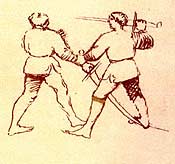 |
One man (right) immobilizes
his opponent's sword by stepping on it while doing a wrist grab.
Flos Duellatorum Pissani-Dosi MS Carta 14 B.
|
Each copy of the Fior di Battaglia has not only its charm, but each
is vitally important to understanding the art. There are concepts buried
in each one that are particularly important for understanding the art
as a whole. The Pissani-Dossi is interesting in that it is probably the
last surviving copy made, includes techniques not included in the other
two copies (but clearly from the same art), starts with a Latin prologue,
distills the explanations of techniques into rhyming couplets (a blessing
and a curse), and has this wonderful known history about it, including
the connection with Francesco Novati. The Getty is the most comprehensive
when compared on the basis of number of techniques, illustrations and
textual information and it contains the key to understanding the footwork
and power generation systems of Fiore’s art. It also has the finest
art of the three. The Pierpoint-Morgan contains extra sentences of text
that are vital to some of the plays, and holds the key to understanding
leverage and timing in Fiore’s swordplay. Unfortunately it lacks
the dagger and hand-to-hand sections of the other two copies.
DKB: I would really like to go to the Morgan and take a look at some
point, but, unfortunately, they are undergoing major renovation, and
won't reopen until 2006. I remember when I watched your class at the
Western Martial Arts Workshop in New York City two years ago, that your
class was very orderly, as compared to some of the other classes. Is
that you or Fiore, do you think?
BC: It’s both of us, because I like a systematic approach, and
that’s what drew me in part to Fiore’s work. The Fior di
Battaglia, even though laid out in slightly different ways in each of
the copies, is very systematic in its approach. In the Getty-Ludwig copy
that I have been doing the majority of my work with, the student starts
with hand to hand combat, moves on to unarmed techniques against the
knife, then knife against knife, then knife against sword, then sword
in one hand, then sword in two hands, then armoured swordplay, armored
pollaxe and armoured spear. The treatise finishes with techniques from
horseback. The student is guided through principles that build upon one
another, starting with manipulating the balance of the human body and
various arm locks, then striking and covering against strikes, then through
a progression of weapons, all of which continually refer back to the
original balance disruption, arm lock and striking principles learned
earlier.
A significant difference between the Fior di Battaglia and modern educational
works is the experiential way that Medieval instructors expect you to
learn. The modern method usually puts all the basics concepts down first
and then proceeds with individual techniques. The point being, in my
opinion, that Fiore’s art was intended for educated individuals
who would have recognized the basic principles of Aristotle’s physics
and Euclid’s geometry within the art. In effect, the educated person
already had what he needed for the basics of the art from the trivium
and quadrivium – the undergraduate work of the Medieval educational
system. As they practiced the plays set down by Fiore, they would have
physically experienced those principles they had previously learned,
and those principles would inform corrections and improvements in the
techniques.
DKB: One of the things that interested me, as an Asian-style martial
artist, was the philosophical aspect of Fiore’s system (i.e., the
lynx with the calipers, the lion, the tiger, and the elephant). How common
was it, in European Medieval thinking, to have such a philosophical underpinning
for martial study? Was Fiore’s application of it unique?
BC: This type of symbolism can be seen in “segno,” or representation,
pages of many manuscripts. There is one of these pages in the Pissani-Dossi
manuscript, and another in the Getty-Ludwig. The most prevalent symbol
is the compass, which also appears in Filippo Vadi and the Codex Wallerstein,
among others. The compass is the device used to measure the world (the
very meaning of the word geometry). It is also a symbol for the all-seeing
and designing eye of God, and so it appears in Fiore’s segno page
as the instrument of the lynx that symbolizes the virtue of prudence,
the ability to see the unseen, and which always places itself with the
compass and rule as it measures the world.
So certainly this kind of symbolism is prevalent in and appropriate
to the period of history that produced these treatises of fighting arts.
Fiore’s application of it was not at all singular, but part of
an approach used by “magistri” or teachers of almost any
art of the time.
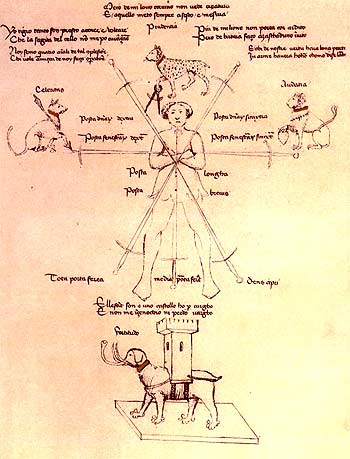 |
A diagram showing the lynx (top), the lion (right), the tiger (left)
and the elephant (bottom). Flos Duellatorum Pissani-Dosi MS Carta
17 A. |
The Medieval and Renaissance world view was based on the
scientific, ethical, and religious principles of the day. To have four
animals representing
four virtues which the scholar should strive to have a part of parallels
the four humours which exist to some lesser or greater extent and in
some balance within each person. The individual animals have qualities,
some mythical, some real, that are identified in works of the period
called “bestiaries.” These books deal with the animals as
symbols. When a person of the time saw a lynx, he would know it had superior
powers of eyesight and perception. Because the lynx holds the calipers
it would be understood that the lynx employs geometry, aided by this
heightened perception. The lion with its brave heart is a symbol which
persists to this day, but the lion is also known for mercy, watchfulness
and as a symbol of law. The tiger with its arrow symbolizing quickness
is also a symbol of tenacity without wisdom, relentless pursuit, or the
unbridled passions of man. The elephant with its ties to the earth, and
the burden of a castle on its back, speaks to footwork and balance, and
represents strength and perseverance. These animal symbols have layers
of meaning which address the physical, the religious, the ethical, etc.
They are memory devices, as are many of the turns of phrase, symbols
and references within the treatise. Even the number of fighting positions
in each section is important as a memory aid and a reference, because
every number had layers of meaning to the Medieval and Renaissance individual.
So these symbols in all their forms were a memory aid, a set of scientific
principles, and a source of ethical guidance to the scholar. Moral and
religious considerations were seen as absolutely necessary to the scholar
of the art of arms, and this is consistent with a world view that saw
everything as an interrelated whole. Mathematics and geometry and astronomy
and music were taught and learned using the same principles, and were
seen as highly related to one another. The same geometrical proportion
formed a swordsman’s footwork and the building of a cathedral.
The same moral lessons instructed the scholar of arms and the student
of law. It makes perfect sense then that such teachings would be properly
included in a book instructing the use of arms.
DKB: Did other manuals of technique from the same period (as far as
we know) employ a systematized method, the way the Fior di Battaglia
does?
BC: Yes, many of them do. Keep in mind that some of the works are actually
collections from parts from several different treatises in one volume.
These were compiled by Medieval or Renaissance collectors. These may
seem more random in nature if one views them as single works, which they
are not. Many, many other works are by single authors and include very
systematic approaches to teaching the art. They include everything from
the late 13th century sword and buckler manuscript known as Towner Manuscript
I.33, with its coding of plays with a cross to indicate a new sequence
of techniques, to the complexity of the 17th century master Thibaut’s
lavishly illustrated memory palaces. When modern individuals look at
these works, they judge them through a modern set of sensibilities, and
risk missing the beauty and complexity of them because they aren’t
yet educated as to what they are looking at.
I’ve heard some respected historian claim Fiore’s work was “unorganized” and
that he “got lost in fantasy fights” when nothing could be
further from the truth. It just takes study of the proper context of
these masters’ teachings to bring to light just how effective they
were as martial artists and teachers. It’s a task that requires
historians, translators, martial artists and fresh eyes with no pre-conceived
notions to sort it out. When viewed through Medieval and Renaissance
sensibilities, these are brilliant works that are clearly created by
those who were masters of their art. These arts were taught using scientific
principles, animal, number and other symbolism, and made use of systems
of memorizing material that were familiar to the scholars of the time.
In addition, they strove to maximize the beauty and efficiency of their
art by being in harmony with natural principles. Their grasp of how to
impart that knowledge to their contemporaries through a systematic framework
appropriate to the time is a skill that should merit our highest esteem.
DKB: I find that sort of holistic approach to training is also what
seems to attract people to traditional Japanese arts. Are there any precedents
for Fiore's approach? Did any of his teachers leave any writings that
we know of?
BC: I believe people are attracted to holistic training because they
innately know it to be the correct way to learn. To isolate something
out of context of the world it exists in is to truly disconnect it and
in the process lose much of its meaning. If something is truly in harmony
with natural laws, it will be absorbed much more easily and related to
everything else in life – into the larger whole.
There are precedents for Fiore’s approach in the scholastics of
his time, and of those who came long before him in the classical world,
but Fiore is one of the earliest treatises on fighting arts that we have
from Europe. The oldest so far discovered is the late 13th century treatise
known as Tower Manuscript I.33. This treatise shows a scholar and a priest
executing a large selection of techniques with sword and buckler, and
is based on a system of guards and counter-guards.
We unfortunately do not have access to any of the writings of Fiore’s
teachers. Two of the copies of Fiore’s treatise state only that
he learned from both Italian and German masters. The Pissani-Dossi copy
names two German masters rather vaguely – Nicholas of Toblem and
Johannes Suvenus. Yet due to differences from the other two copies and
the large number of individuals with these names, it makes it quite difficult
to substantiate anything concerning them. Through the civic records of
the period we know that Fiore’s home province of Friuli provided
many fencing masters resident in the cities of Cividale and Udine, and
certainly from his youth he would have had access to systematic instruction
in arms.
DKB: You have not only translated the Getty version of the Fior di Battaglia,
you also teach the techniques. How did teaching help in interpreting
the techniques?
BC: That’s the great challenge of taking on the interpretation
of these treatises. First you have to struggle through the nuances of
languages that are not spoken in that particular form any more. Once
you get to the point where you believe you can reasonably understand
what they are trying to communicate, then you can set yourself to the
task of reproducing the techniques. Consequently you are constantly humbled,
corrected, and your work revised. It will always be a work in progress,
and one must accept that.
The input of other accomplished martial artists is absolutely vital,
but you must be careful not to make Fiore’s art into something
it is not. While a particular lock or throw may look at first glance
like a counterpart from judo or aikido, it may have important differences
in mechanics. You can’t just immediately respond with, “I
know what that is.”
Interestingly, every time we’ve had a problem with a technique,
the illustrations and text held the key to correction. Some say that
Medieval artists were little more than cartoonists who couldn’t
properly represent physical actions. Nothing could be further from the
truth with regard to the artist of the Getty-Ludwig manuscript. Tiny
details of foot or hand position, or where the weight is distributed
make huge differences, and the artist was able to realistically capture
these.
The goal is to do exactly as the text says, make it look exactly like
the illustration looks, and make it effortless so that it works against
people larger and stronger than you. We’ve been able to do that
with all the techniques so far. The next level is making them work at
speed. This takes practice, safety equipment and trusted opponents, as
many of the techniques are designed to dislocate joints, break bones
or throw the opponent on his head. We’re able to this with the
vast majority of the techniques. The final stage is to be able to implement
them reflexively against a resisting opponent who is also trying to do
the same to you. We’ve been working on this, and again this requires
great care for, and trust in, your training partner. It also requires
that you overcome years of conditioned reactions from other sports so
that you can more sincerely address the art you’re studying and
limit yourself to the techniques in the treatise. The prologue of the
Pissani-Dossi manuscript approaches this safety issue, telling us to
practice them “in Concordia” rather than in anger.
Having to teach the techniques is of course very valuable in understanding
them, because you have to be able to break the technique into their component
parts in such a way that the parts are taught effectively and in a manner
that they can be easily assembled into a coherent whole. All the other
instructors I have bombarded with questions, all the people who have
attended seminars of mine, and especially my long-suffering and patient
students at St. Martins Academy, have been invaluable in this regard.
Their questions and challenges are what have brought the interpretation
much farther than I ever could have brought it alone.
About the Interviewer
Deborah Klens-Bigman is Manager and Associate Instructor of iaido at
New York Budokai in New York City. She has also studied, to varying extents,
kendo, jodo (short staff), kyudo (archery) and naginata (halberd). She
received her Ph.D in 1995 from New York University's Department of Performance
Studies where she wrote her dissertation on Japanese classical dance
(Nihon Buyo), and she continues to study Nihon Buyo with Fujima Nishiki
at the Ichifuji-kai Dance Association. Her article on the application
of performance theory to Japanese martial arts appeared in the Journal
of Asian Martial Arts in the summer of 1999. She is married to artist
Vernon Bigman. For FightingArts.com she is Associate Editor for Japanese
Culture/Sword Arts.
|